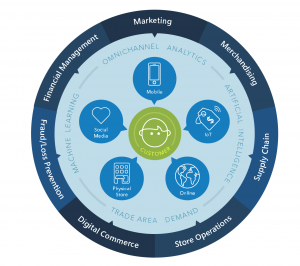 Just last week, Walmart announced that they'll be testing inventory management robots. These robots will cruise store aisles, scanning shelves to identify out-of-stock products and other issues. According Reuters, Walmart is testing these camera-equipped robots in a handful of stores, but plans to expand the test to 50 stores.
Just last week, Walmart announced that they'll be testing inventory management robots. These robots will cruise store aisles, scanning shelves to identify out-of-stock products and other issues. According Reuters, Walmart is testing these camera-equipped robots in a handful of stores, but plans to expand the test to 50 stores.
We don’t know if the robots will be on the floor 24/7, but it’s clear they'll be able to sample inventory levels faster than what's humanly possible. Even in the early days of the rollout, Walmart will gain valuable insights from all of this streaming data which could be applied not just for that individual store, but chain-wide.
But months before the products get to that shelf and the robots start rolling, the retailer has to plan the ideal assortment mix, orders and number of units. Merchandise teams are doing their best to predict what the hot new products will be, which items customers prefer to shop for online and, most importantly, dial in the ideal price to be competitive.
That's what retailers call 'merchandise planning,' and it involves many steps and disciplines such as SKU rationalization, assortment optimization, store clustering, category management and demand forecasting. To orchestrate the decision making with massive amounts of data, major retailers use high performance in-memory applications powered by analytics to get the job done.
Recently both Forrester and Gartner completed exhaustive research to evaluate how the major software vendors’ applications stack up. These independent analyst firms both agree on two important things:
- In a unified commerce world, the merchandise planning process needs expand to include new teams such as marketing, supply chain and digital commerce.
- For the modern-day planning system, baked-in analytics is a must-have to quickly perform demand forecasting, customer segmentation, store clustering and machine learning.
SAS Merchandise Intelligence has been showcased and achieved high rankings in these surveys for the past several years. Each firm has some slightly different criteria for evaluation. To learn more, review the Gartner 2017 Magic Quadrant for Retail Assortment Management Applications and The Forrester Wave™: Retail Planning, Q3 2017 reports.
Forrester says, "SAS excels in omnichannel analytics," and "in our evaluation, SAS proved its ability to tackle hard optimization issues by demonstrating best-in-class size and pack optimization, execution road map, global vision innovation road map, partner ecosystem, and supporting products and services."

Along with this recognition, SAS has earned the highest scores for predictive analytics and machine learning solutions in 2017. Now for the third consecutive year, SAS is a Leader in Gartner’s Magic Quadrant for Digital Marketing Analytics. These proven, trusted, open building blocks are the foundation of SAS Omnichannel Analytics. Is your current planning process using retail analytics to give you the best answers? If not, then you need to learn more about SAS Omnichannel Analytics and make sure to visit us at #NRF18 this January.
We welcome your thoughts on this upcoming #saschat hosted live December 21st at 8am EST, 2pm CET to discuss how can leading retailers chart a path in a world of accelerating digital shopping?
- What merchandising priorities are you seeing retailers pursue?
- How are retailers exploiting IoT?
- How is omnichannel analytics different from omnichannel conversation?
- How are retailers impacted by fraud across multiple channels?
- Why are retailers seeing chat interface replacing search interfaces on websites?
- What do you feel the NRF conversation will be about?
